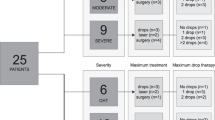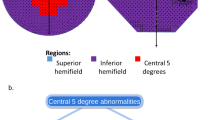Abstract
Purpose
To determine whether a purpose-built glare tester, in combination with new glare-specific questions, can better assess glaucoma patients’ experience of glare and visual disability than visual acuity (VA) or visual fields alone.
Patients and methods
Consecutive patients attending for visual fields in a single glaucoma clinic from 03/06/2019–01/11/2019 underwent VA assessment using a Brightness Acuity Tester as a glare source, examination for media opacities, and completed the VFQ-25 with four additional glare-related questions. One hundred and sixteen eyes (64 patients) were included for analysis. The amount of disability glare (VA reduction due to glare) was compared according to presence/absence of media opacity and glaucoma severity. Subjective glare symptoms were compared with objective disability glare measurement using a Bland–Altman plot.
Results
Patients with advanced–severe glaucoma had significantly worse disability glare than those with mild–moderate glaucoma. VA reduction due to glare from mild–moderate to acute–severe glaucoma (mean −3.4 letters, P = 0.01, CI −0.8, −6.0) was of almost identical magnitude to that due to presence of any media opacity (mean −3.3 letters, P = 0.03, CI −0.4, −6.2). There was a trend towards greater disability glare in more symptomatic patients, with good agreement between subjective and objective glare measurements for those with few glare signs or symptoms, but progressively more variation either side of agreement as either measurement worsened.
Conclusions
Glaucoma is associated with objective and subjective acuity reduction in the presence of glare. We demonstrated an increase in disability glare in patients with more severe glaucoma. The worse the glare symptoms or signs, the more variable the agreement between objective and subjective assessments.
Similar content being viewed by others
Login or create a free account to read this content
Gain free access to this article, as well as selected content from this journal and more on nature.com
or
References
Bhorade A, Perlmutter M, Wilson B, Kambarian J, Chang S, Pekmezci, et al. Differences in vision between clinic and home and the effect of lighting in older adults with and without glaucoma. JAMA Ophthalmol. 2013;131:1554.
Aslam T, Haider D, Murray I. Principles of disability glare measurement: an ophthalmological perspective. Acta Ophthalmologica Scand. 2007;85:354–60.
Goldberg I, Clement C, Chiang T, Walt J, Lee L, Graham S, et al. Assessing quality of life in patients with glaucoma using the glaucoma quality of Life-15 (GQL-15) Questionnaire. J Glaucoma. 2009;18:6–12.
Enoch J, Jones L, Taylor D, Bronze C, Kirwan J, Jones P, et al. How do different lighting conditions affect the vision and quality of life of people with glaucoma? A systematic review. Eye. 2019;34:138–54.
Janz N, Wren P, Lichter P, Musch D, Gillespie B, Guire K, et al. The collaborative initial glaucoma treatment study interim quality of life findings after initial medical or surgical treatment of glaucoma. Ophthalmology. 2001;108:1954–65.
Rubin G, Bandeen-Roche K, Huang G, Muñoz B, Schein O, Fried L, et al. “The association of multiple visual impairments with self-reported visual disability: SEE Project.”. Investigative Ophthalmol Vis Sci. 2001;42:64–72.
Nelson P, Aspinall P, Papasouliotis O, Worton B, O’Brien C. Quality of life in glaucoma and its relationship with visual function. J Glaucoma. 2003;12:139–50.
American Academy of Ophthalmology. Contrast sensitivity and glare testing in the evaluation of anterior segment disease. Opthalmology. 1990;97:1233–7.
Mainster M, Turner P. Glare’s causes, consequences, and clinical challenges after a century of ophthalmic study. Am J Ophthalmol. 2012;153:587–93.
Elliott D, Bullimore M. Assessing the reliability, discriminative ability, and validity of disability glare tests. Investigative Ophthalmol Vis Sci. 1993;34:108–19.
Neumann A, McCarty G, Locke J, Cobb B. Glare disability devices for cataractous eyes: a consumerʼs guide. J Cataract Refractive Surg. 1988;14:212–6.
Frost N, Sparrow J. Use of vision tests in clinical decision making about cataract surgery: results of a national survey. Br J Ophthalmol. 2000;84:432–4.
Mills R, Budenz D, Lee P, Noecker R, Walt J, Siegartel L, et al. Categorizing the stage of glaucoma from pre-diagnosis to end-stage disease. Am J Ophthalmol. 2006;141:24–30.
Chylack L, Wolfe J, Singer D, Leske M, Bullimore M, Bailey I, et al. The lens opacities classification system III. Arch Ophthalmol. 1993;111:831.
Kniestedt C, Stamper R. Visual acuity and its measurement. Ophthalmol Clin North Am. 2003;16:155–70.
Mangione C, Lee P, Gutierrez P, Spritzer K, Berry S, Hays R. Development of the 25-list-item National Eye Institute Visual Function Questionnaire. Arch Ophthalmol. 2001;119:1050.
Green J, Siddall H, Murdoch I. Learning to live with glaucoma: a qualitative study of diagnosis and the impact of sight loss. Soc Sci Med. 2002;55:257–67.
Mangione C. Nei.nih.gov. 2000. https://www.nei.nih.gov/sites/default/files/2019-06/manual_cm2000.pdf. Accessed 17 Feb 2020.
Giavarina D. Understanding Bland Altman analysis. Biochemia Med. 2015;25:141–51.
Siah W, O’Brien C, Loughman J. Macular pigment is associated with glare-affected visual function and central visual field loss in glaucoma. Br J Ophthalmol. 2017;102:929–35.
Adamsons I, Vitale S, Stark W, Rubin G. The association of postoperative subjective visual function with acuity, glare, and contrast sensitivity in patients with early cataract. Arch Ophthalmol. 1996;114:529.
Elliott D, Hurst M, Weatherill J. Comparing clinical tests of visual function in cataract with the patient’s perceived visual disability. Eye. 1990;4:712–7.
Tubach F. Evaluation of clinically relevant states in patient reported outcomes in knee and hip osteoarthritis: the patient acceptable symptom state. Ann Rheum Dis. 2005;64:34–7.
Quintana J, Aguirre U, Las-Hayas C, Gonzalez N, Garcia S, Escobar A. Use of the patient acceptable symptom state and the minimal clinically important difference to evaluate the outcomes of cataract extraction. Am J Ophthalmol. 2011;152:234–43.e3.
Tan J, Spalton D, Arden G. Comparison of methods to assess visual impairment from glare and light scattering with posterior capsule opacification. J Cataract Refractive Surg. 1998;24:1626–31.
Author information
Authors and Affiliations
Corresponding author
Ethics declarations
Conflict of interest
The authors declare that they have no conflict of interest.
Ethics statement
This study was a retrospective review of routinely collected clinical data. As such it is registered with our audit department as data exploration.
Additional information
Publisher’s note Springer Nature remains neutral with regard to jurisdictional claims in published maps and institutional affiliations.
Rights and permissions
About this article
Cite this article
Hamedani, M., Dulley, B. & Murdoch, I. Glaucoma and glare. Eye 35, 1741–1747 (2021). https://doi.org/10.1038/s41433-020-01164-8
Received:
Revised:
Accepted:
Published:
Issue Date:
DOI: https://doi.org/10.1038/s41433-020-01164-8
This article is cited by
-
Evaluation of the association between macular damage and disability glare in patients with advanced glaucoma
Graefe's Archive for Clinical and Experimental Ophthalmology (2022)



